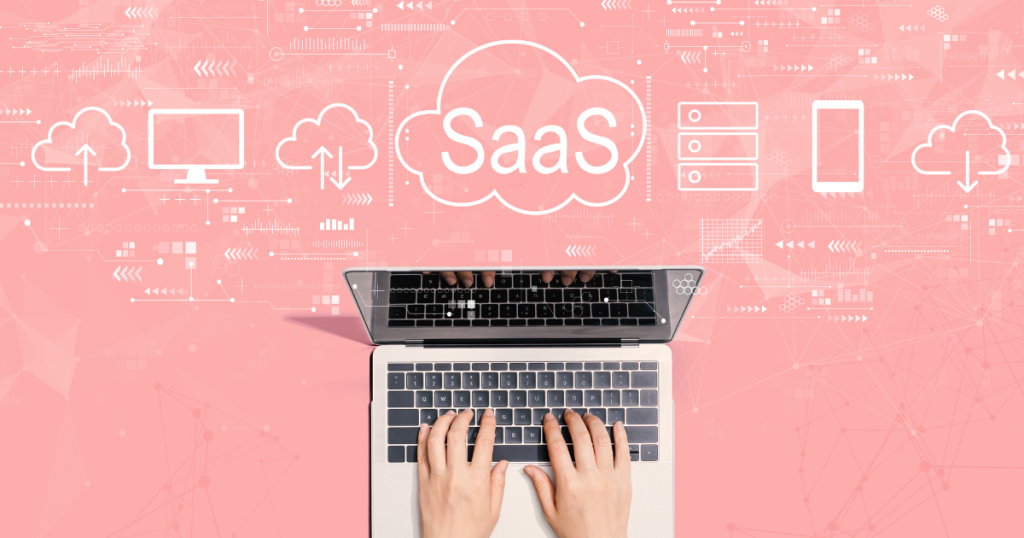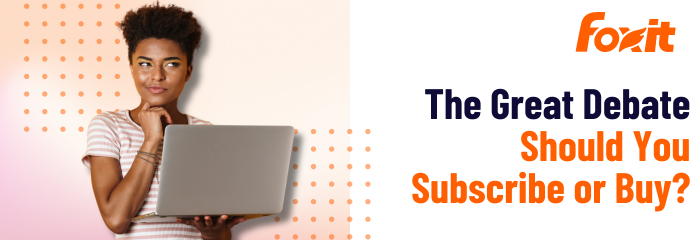- August 19, 2024
- FOXITBLOG
Dotting Twitter posts and scattered throughout Reddit threads, you’ll encounter a subject of increasing debate. And no, it’s not the impact of avocado toast vs housing affordability or the ethics of artificial intelligence usage in robotics (shivers at robot dogs). It’s the subject of digital ownership.
You may (or may not) be surprised at how divided the internet is on this subject. Everyone has personal preferences and effectively draws a hard line in the sand against one or the other. So, with all of these differing opinions, how do you decide what’s right for you? What’s right for your business?
Let’s begin where we always prefer to start – the numbers. Because numbers don’t lie, and they certainly don’t bend to winds of opinion.
Subscription vs Ownership: Just the Facts
- According to a study of 13,000 people conducted by Washington State University, a scale-tipping 74% of adults surveyed are convinced that subscription-based models for things like food, clothing, software, music, movies, and other goods are here to stay.
- Interestingly, the same Washington State study concluded that more than half of people (57%) are no longer interested in owning these goods.
- And how many adults are subscribed to at least one service? 70%. Five years ago, this number was 50%. That’s a significant jump.
Now that we’ve peeked at the numbers, which overwhelmingly stack up in favor of subscription services, we’re left with the question of why. Well, this same study provides some pretty interesting insights:
- First on the list? People simply aren’t interested in being weighted down by owning things anymore. The study states, “People aren’t as interested in filling their homes with physical goods anymore. They don’t want to deal with upfront costs, the hassles of maintenance, and the frustration of obsolescence. Why buy and own something if there is an easier way to get the same or even better outcome?”
- Status is no longer defined by ownership. Now, this is a big one. As the study points out, people nowadays are more interested in experiences than in owning cool things. Need further proof? Simply scroll through your Instagram feed. To quote the Washington State, “Experiences are the new status symbol.”
- Furthermore, the study’s participants consider ownership of goods to be more of a burden than anything. According to the university’s study, “They free themselves from maintenance and upkeep on all of these things. Why hassle with ownership when you can just use things whenever and however you need them?“
- Cost is also noted as a significant driving factor. Simply put, ownership often requires more upfront costs and limits customers’ access to selections. The study provides a convincing example, stating, “Just a few years ago, people had to purchase CDs at a cost of $15 to $20 each if they wanted to enjoy their favorite band’s new offering. Today, for a subscription price of about $10 per month, they can enjoy unlimited music from unlimited groups through services such as Spotify and Pandora. True, they do not own anything—but what difference does it make when they can listen to the music they love anytime, anywhere, at the push of a button?“
Now, this does not imply that product ownership is without its merits. In truth, it’s the opposite for some. And you can forget about bragging rights; boasting is irrelevant here. The choice is driven by personal taste. Really, if you thrust the options of both subscription and product ownership under a magnifying glass, you’ll find the differences to be predominately preference-driven.
What Are the Benefits of Subscription vs Perpetual Software?
Let’s bring that magnifying glass over here and take a closer look at what we mean.
- Cost-Effectiveness Over Time vs. Lower Initial Cost: Ownership often involves a one-time purchase that may be cheaper in the long run, while subscriptions typically have lower upfront costs, making them more accessible initially.
- No Recurring Fees vs. Regular Updates and Improvements: Owning a product eliminates ongoing payments, while subscriptions provide regular updates and new features without additional costs.
- Complete Control vs. Access to the Latest Technology: Owners have complete control without restrictions, while subscribers benefit from access to the latest technology and innovations as they are released.
- Personalization and Customization vs. Flexibility and Scalability: Ownership allows for modifications that are not always possible with subscriptions, whereas subscriptions offer flexible terms and scalability to meet changing needs.
- Long-Term Reliability vs. No Maintenance Responsibility: Ownership is preferred for durable goods with long-term reliability, while subscribers are not responsible for maintenance or repairs, which the provider handles.
- Availability of Use vs. No Long-Term Commitment: Owned products are always available for use, while subscriptions offer the flexibility of short-term use without long-term commitments.
- Simplicity and Convenience vs. Bundled Services and Features: Managing ownership is simpler without tracking renewals, whereas subscriptions may include bundled services and features, enhancing overall value.
Considering these facts and comparisons, where does that leave software as a service (SaaS) products? When comparing the two, you’ll hear familiar echoes of the same pros and cons we just listed. Alas, it’s all about perspective, though, isn’t it? What works for filling your closet may not be your optimal choice for software. Which brings us to…

Subscription as a Service (SaaS) vs Perpetual Software Licensing
Cost Structure:
- SaaS: This involves lower initial costs with subscription-based pricing, which can be more accessible but requires recurring monthly or yearly charges.
- Perpetual: Requires a higher upfront investment with a one-time purchase, which can be more cost-effective in the long run but may present a barrier for some users.
Updates and Maintenance:
- SaaS: Offers automatic updates and improvements, ensuring access to the latest features and reducing the IT burden for maintenance and security.
- Perpetual: Users must manually update or purchase new versions, potentially missing out on new features without additional costs, and are responsible for maintenance and security.
Flexibility and Scalability:
- SaaS: Provides scalability and flexibility to adjust resources based on current needs, which is ideal for businesses with fluctuating demands.
- Perpetual: Offers limited scalability, as licenses are fixed and may need help to adapt to changing business needs.
Longevity and Reliability:
- SaaS: Relies on the provider’s continuity and service terms, with risks if the service is discontinued.
- Perpetual: This option offers long-term reliability, allowing users to continue using the software as long as it meets their needs without service interruptions.
Access and Availability:
- SaaS: Enables access from anywhere with an internet connection, facilitating remote work and collaboration but dependent on stable connectivity.
- Perpetual: Can often be used offline, providing reliability without internet dependency but limited to the installed environment.
Questions to Ask When Weighing Perpetual Licensing vs Subscription Software
Do you feel like you’re in a bit of a red versus blue pill situation? That tracks. Try asking yourself these questions before you click.
- What are the upfront costs of purchasing versus the ongoing subscription fees, and which option is more affordable in the long run?
- How important is access to the latest features and updates, and are these typically included with a subscription?
- Are your needs likely to change over time, and does the software need to scale accordingly? Is scalability more effortless with a subscription?
- Do you need remote access or offline functionality often offered by cloud-based subscriptions?
- Does your budget allow for a one-time purchase, or is it more manageable to spread costs over time through a subscription?
- What level of support and maintenance is included, and does a subscription provide ongoing support services?
- What are the security and privacy implications of both options, primarily if the software handles sensitive data?
In the end, the choice between SaaS and perpetual licensing is not just a financial decision; it reflects your priorities, business needs, and perception of value. Ultimately, the decision rests with you—what will it be: the certainty of ownership or the flexibility of subscription?
Fortunately, you don’t have to choose with Foxit PDF. We offer a variety of subscription options and a perpetual licensing model, meaning you have the freedom to select the option that works best for you, not the other way around.
